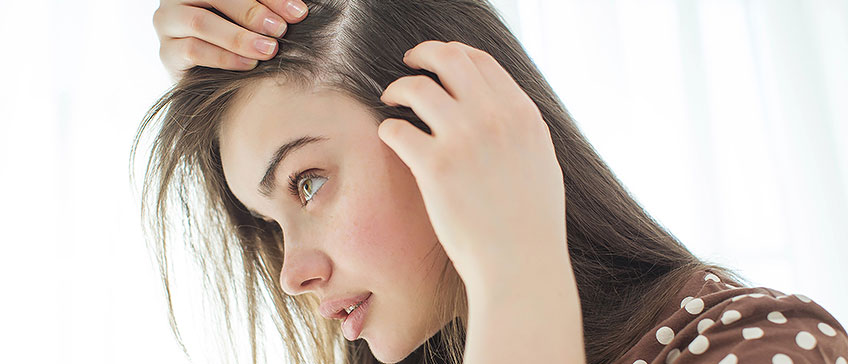Hair loss most commonly affects middle-aged men, but this unpleasant problem also affects women – statistics say that up to 30% of women are experiencing hair loss and thinning. Female baldness causes both dissatisfaction and lack of confidence.
Hair loss (alopecia) has a number of causes, including hormonal problems, illness, taking some type of medication, hereditary factors, stress and negative environmental influences. There are several types of alopecia – in some alopecia we notice focal hair loss, while in others hair is thinned throughout the scalp.
Hair loss is a natural part of the hair life cycle – hair grows, reaches full length, lasts for a while, then falls out, and new hair grows in its place. There are 70 - 100 hair fallings daily and this is completely normal, with an emphasis on hair loss while washing. However, if you notice a loss of more than 100 hairs per day, it may be some type of alopecia.
Although men are more often affected by hair loss, statistics say that women make up as much as 30 % of the total population affected by some form of alopecia.
Hair loss in women typically occurs at an older age than men, but unfortunately, even younger women are not necessarily protected from various forms of hair loss. Thus, women’s baldness becomes an aesthetic problem and concern for many women, regardless of age.
Some forms of hair loss can be stopped by proper care, changing habits, mesotherapy treatments, or certain medications – earlier intervention means a greater chance of success. In other forms, it may not be possible to stop hair loss and stimulate new hair growth, but timely interventions can improve appearance and prevent stress and discomfort due to baldness, such as FUE hair transplantation.
If you have this problem, you can get all the support and care you need at the Bagatin Clinic.
The most common cause of hair loss in women – androgenic alopecia
As with men, the most common cause of hair loss is androgenic alopecia. However, the typical way of hair loss due to this type of alopecia is different in men and women.
While men usually lose their hair first time at the flaps and then the scalp, with only temples, the scalp and nape of the neck, in women, androgenic alopecia usually manifests as hair loss first on the parting area, and then on the scalp. Hair is thinned, but there is rarely such a dramatic loss of hair as in men.
Experts use the Ludwig scale to estimate the degree of hair loss in women, while the Norwood-Hamilton scale is used with men.
According to Ludwig’s scale, the first stage is minor hair loss on the parting, which can be covered with a haircut and a different way of combing. In the second stage, there is a greater loss of hair on the parting area and a general thinning of the hair. In the third stage, the scalp is visible, and thinning of the hair is visible on the rest of the scalp.
Androgenic alopecia – influence of male sex hormones on follicles and other causes
Androgenic alopecia is a condition in which androgens, the male sex hormones, normally present in women, also adversely affect the vitality of the follicles. Their action in some people can prolong the time it takes to grow new hair and thins it – so instead of full and healthy hair, thinner and weaker hairs grow until they completely stop growing.
Usually, hair thinning and hair loss in women is noticeable in menopause or older.
The background of androgenic alopecia can also be hormonal problems, polycystic ovary syndrome or some type of tumor, so it is important to approach this condition holistically, with an analysis of hormones and general health of the body.
Alopecia areata – focal type of alopecia
Alopecia areata is the second most common form of baldness. It is a focal hair loss in a larger or smaller area of the scalp or body. It is equally common in both sexes. If all the hairs fall out, we are talking about total alopecia, and when all the hairs and body hair as well fall out, it is a so-called universal alopecia.
It occurs for a variety of reasons, most often due to an autoimmune disorder in which the immune system attacks the follicles and thus causes excessive and rapid hair loss. It is equally noticed with men and women.
This type of baldness can also occur after exposure to high stress, as well as in people who have elevated thyroid antibodies.
Unlike androgenic alopecia, which causes permanent hair loss, with alopecia areata hair regrows again in 90 % of cases. About half the people affected by this condition will have their hair regrown within half a year.
Telogenic effluvium
Telogenic effluvium is a condition in which the hair enters a resting state to soon, and then falls out prematurely. This causes too many hairs to be lost that cannot be restored, resulting in thinning hair throughout the scalp.
It is usually a temporary hair loss and the hair will regrow.
The causes of telogenic effluvium are different – sometimes it is a matter of exposure to high stress, toxins from the environment, the consequences of some diseases or taking certain types of medicine. Sometimes it occurs in menopause or during pregnancy and after childbirth, and a possible cause is the lack of micronutrients in the body (iron, zinc, vitamin B).
How to prevent hair loss in women?
If you notice increased hair loss, you should see a dermatologist immediately. The doctor will diagnose the stage of alopecia and the possible background cause of this condition. These can be some diseases, nutrients lack, hormonal problems, genetic predispositions, etc. Based on the insight into the causes and stage of alopecia, the dermatologist will suggest treatment methods.
At Bagatin clinic, we offer several quality and medically proven methods that can stop hair loss – or restore lost hair if there is no way for the hair improving on its own.
What can help hair with the capacity to regenerate are two excellent treatments – mesotherapy and stem cell therapy from your own blood. These treatments deeply nourish and recover the hair follicles and all cells of the scalp, helping to preserve and regrow hair.
Alopecia treatment methods
Mesotherapy is a non-surgical and minimally invasive method of aesthetic dermatology. Helps the scalp to recover by injecting cocktails of vitamins, minerals, antioxidants, hyaluronic acid and other active substances directly into the scalp. This method has been used for over sixty years for hair restoration, but also for rejuvenating face and body skin and has very good results. Hair that falls out due to lack of nutrients or similar difficulties, hereby receives a strong incentive to restore and stop the process of hair loss.
Hair thinning therapy with own blood is an innovative method in which the use of blood plasma from one’s own blood promotes scalp renewal. Platelets, bio-active substances and growth factors naturally found in blood plasma are natural and effective ways of nourishing and promoting cell regeneration.
Androgenic alopecia can also be treated with certain medications (minoxidil, finasteride, antiandrogens or estrogens), but given that these drugs are potentially toxic, the decision to take them must be made by a specialist dermatologist.
It is important to note that at Bagatin Clinic, these medicines are available in the form of sprays or gels for topical application, which also provides an equally effective hair growth stimulant without the side effects that may occur when taken as tablets. Topical application of these sprays and gels is recommended after a hair transplant at least one year after the transplantation is done, along with the hair thinning therapy with won blood treatment, to further promote hair growth and surgery success. The main treatments for alopecia areata are usually corticosteroids, which can sometimes stop the progression of alopecia and help preserve hair.
FUE hair transplantation
The only permanent solution for lost hair due to androgenic alopecia and other types of irreversible hair loss is FUE method of hair transplantation.
This modern, minimally invasive method, which we successfully use at Bagatin Clinic, grafts follicles from the donor region – where there is more hair – to the recipient region, where the hair is missing. The treatment is performed with very thin needles with which the surgeon pulls out the follicles and then grafts them into areas where the hair is lost. Because it is your own hair, once the hair is grown, natural hair look is achieved.
Recovery from this procedure is very fast – after a week the person can return to their regular activities, and all traces of transplantation disappear on the scalp.
Sometimes a doctor may recommend a combination of multiple treatments – for example, a transplant and mesotherapy or a stem cell method to nourish the scalp and promote the renewal of transplanted hair.
Hair loss is an uncomfortable and very stressful condition for women – so don’t wait. If you notice any signs of alopecia, contact us immediately at Bagatin Clinic. Our team can help with reviews, advice and quality treatments that have helped many women solve their hair loss problem. Learn how to prevent hair loss. Contact us with full confidence!
Free online consultation with our doctors
Send enquiryFeel free to contact us
By phone on +385 1 46 10 225 or through our online contact form
Send enquiry
Locations
| Green Gold Tower Ul. Grada Vukovara 269a/10, 10000 Zagreb |
|
| Donji grad Frana Folnegovića 1c/1, 10000 Zagreb |
|
| Dioklecijan Hotel & Residence Kranjčevićeva 45/1, 21000 Split |
Where to park
| Parking available in Green Gold centre, Zagreb underground garage. For detailed information download a map |

